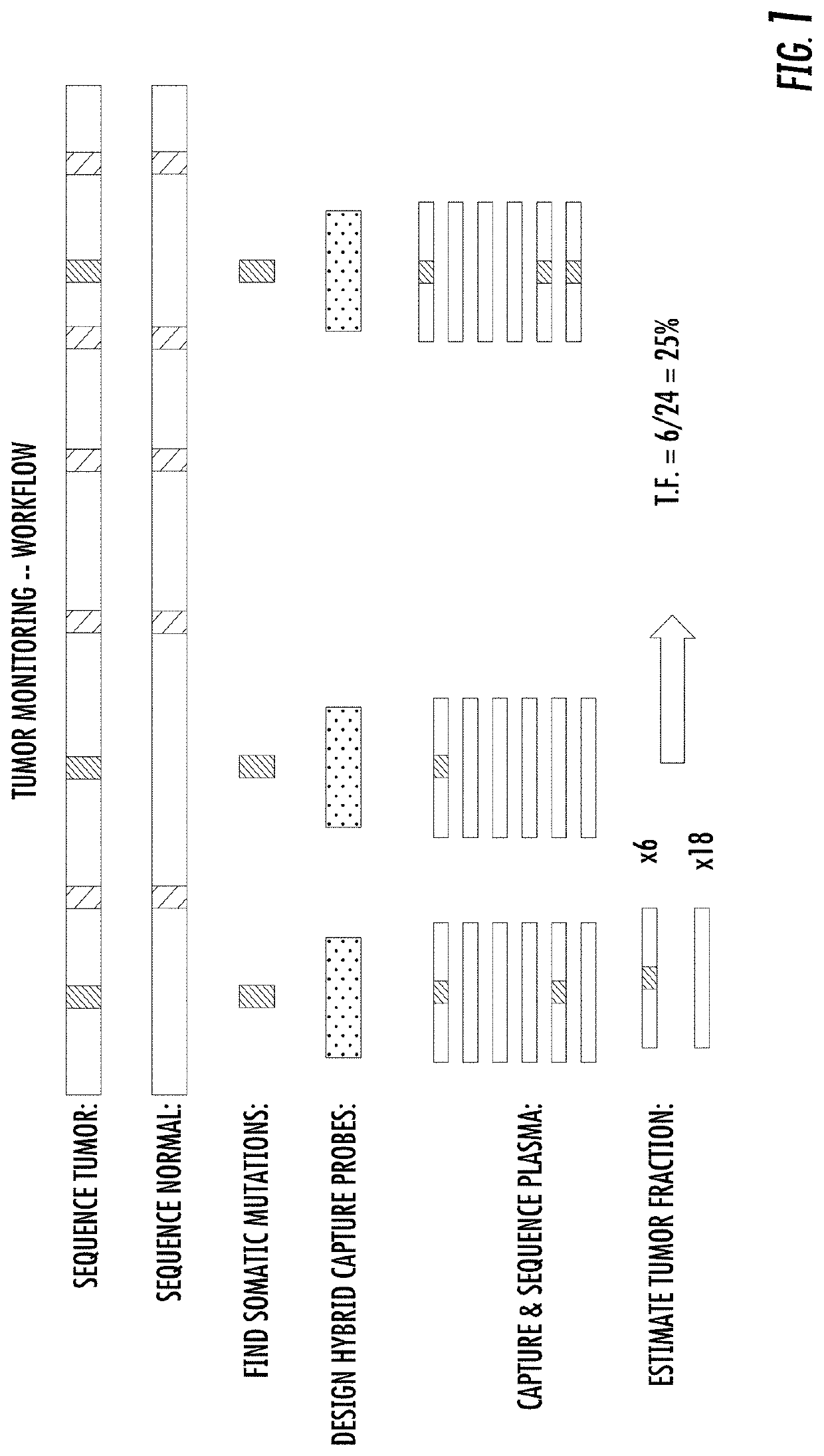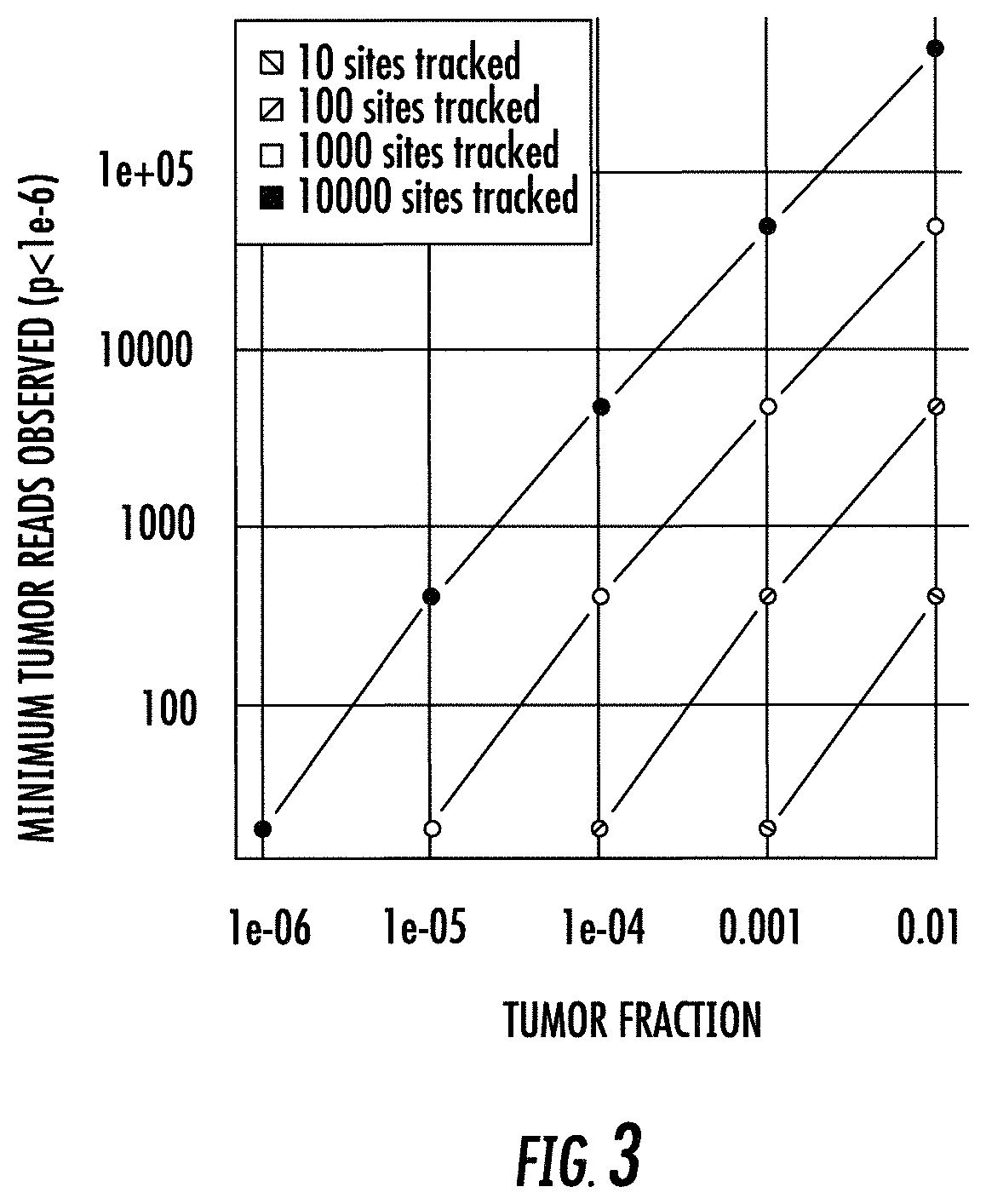Combinatorial DNA screening
a cell-free dna and screening technology, applied in the field of somatic mutation detection in cell-free dna, can solve the problems of difficult inherited mutations that result in disease in fetuses, inability to determine the presence of disease, and difficulty in detecting disease-associated mutations
- Summary
- Abstract
- Description
- Claims
- Application Information
AI Technical Summary
Benefits of technology
Problems solved by technology
Method used
Image
Examples
example 1
Computer Simulation of Determination of Tumor Fraction
[0239]This example is of a computer simulation of an experiment designed to determine the tumor fraction according to the methods provided herein.
[0240]In this example, we assumed a panel of 100 somatic sites were interrogated at a depth of 5000-fold in a virtual sample, i.e., in silico, having a tumor fraction of 1e-4. 100,000 repetitions of the process were performed, and the number of tumor molecules were scored in each case.
[0241]Targeting 100 somatic sites, and sequencing the sites at a depth of 5e3, given a tumor fraction of 1e-4, one would expect to see about 50 tumor molecules in a background of 500,000 normal molecules. Each repetition begins with zero tumor reads. Each site is then scored as yielding some number of tumor reads (potentially zero or more) by the use of a random draw from a binomial distribution with a probability of success equal to 1e-4 and the number of trials equal to 5000.
[0242]For example, the first ...
example 2
Detection of Somatic Mutations in Mixtures of Homozygous and Heterozygous Sequences Derived from a Mixture of Two Samples
[0246]The purpose of this experiment was to assess the ability of the method provided to detect very small mixtures of DNA, on the order of 1 foreign molecule per 1 million “background” molecules, by mixing DNA from two donor samples in known proportions and sequencing it as described.
[0247]Method[0248]1. Extract genomic DNA from two donor samples. Prepare library for each donor that contains molecular barcodes that allow for duplex sequencing, and sample barcode sequences that indicate which sample downstream sequencing reads originated from.[0249]2. Whole-genome sequence the two samples.[0250]3. Select ˜10,000 sites that are homozygous in Sample 1 and heterozygous in Sample 2. Sample 2 was considered as the “cancer” sample.[0251]4. Design and synthesize biotinylated hybrid capture probes targeting those 10,000 sites to enrich for sites containing segregating mar...
example 3
Clinical Samples
[0272]This example discloses the test on three different patient samples
[0273]Samples were obtained from a commercial sample acquisition company. The samples were as follows:
[0274]
TABLE 2SomaticMutationsPatientType and StageSamples AvailableIdentified1067Stage 3c BreastFFPE Tumor, Fresh-Frozen562Tumor, Normal, Pre-OpPlasma1071Stage 3a LungFFPE Tumor, Fresh-Frozen3575Squamous CellTumor, Normal, Pre-OpCarcinomaPlasma2956Stage 1a LungFFPE Tumor, Normal,47AdenocarcinomaPre-Op Plasma, Post-OpPlasma
[0275]The samples were characterized as described herein. Tumor and normal samples were subjected to whole genome sequencing and the somatic mutations were identified. Next, hybrid capture probes were designed targeting all somatic mutations identified for the respective sample. For example, patient 1067 had 562 probes designed for each of the 562 somatic mutations identified. All samples (tumor, normal, cfDNA from plasma) for each patient were re-sequenced using the designed pr...
PUM
| Property | Measurement | Unit |
|---|---|---|
| size | aaaaa | aaaaa |
| size | aaaaa | aaaaa |
| size | aaaaa | aaaaa |
Abstract
Description
Claims
Application Information
 Login to View More
Login to View More - R&D
- Intellectual Property
- Life Sciences
- Materials
- Tech Scout
- Unparalleled Data Quality
- Higher Quality Content
- 60% Fewer Hallucinations
Browse by: Latest US Patents, China's latest patents, Technical Efficacy Thesaurus, Application Domain, Technology Topic, Popular Technical Reports.
© 2025 PatSnap. All rights reserved.Legal|Privacy policy|Modern Slavery Act Transparency Statement|Sitemap|About US| Contact US: help@patsnap.com



